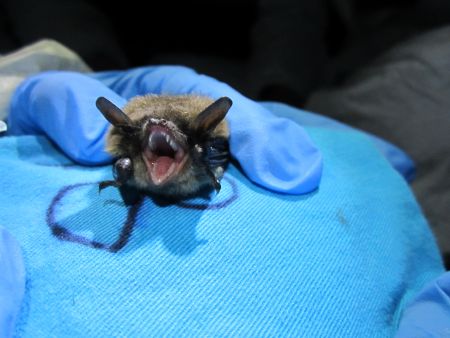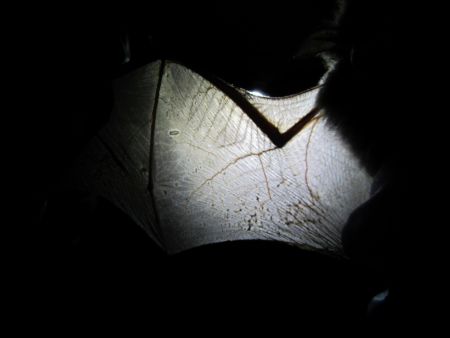Bats are in trouble. Big trouble.
The recently introduced disease white-nose syndrome has made its way from New York, where it was first introduced into North America, to the east coast of Canada. White-nose syndrome (WNS) was confirmed in parts of Nova Scotia and New Brunswick in the winter of 2010-2011, and was just confirmed in PEI this winter.
WNS is a pathogenic fungus infection and thought to be one of the most devastating wildlife diseases to occur in recent times. This past winter it hit mainland Nova Scotia bat populations hard.
Surveys conducted by Dr. Hugh Broders and students at Saint Mary’s University documented declines to bat colonies of more than 95 per cent in just one year.
This epidemic began in North America in 2006, when 50 per cent of bats in New York caves died and showed signs of infection by the fungus, Geomyces destructans. This infection became known as white-nose syndrome because the bats displayed fungus growing from their noses, but it also grows on their wings, penetrating deep into tissue.
The fungus is cold-loving, growing best between 12 and 16 degrees celsius, which is about the same temperature as the caves and mines where bats hibernate. It grows on the bats when they are hibernating, and causes physical damage to their wings and possibly dehydration. Infected bats are known to arouse frequently from hibernation, which uses up a lot of their energy.
Some bats become so desperate that they leave the cave to forage, but it is winter and there is no food available, so they starve or freeze to death. In caves and mines that are infected with WNS, at least 70 per cent of the bats hibernating there perish in the first winter.
It has been hypothesized that the fungus was brought over from Europe from people caving there and then subsequently caving in New York, without cleaning their equipment between adventures (though this is not confirmed). Bats in North America seem to have little resistance to the fungus, and Bat Conservation International (batcon.org) reports that 5.7 million bats have died since the introduction in New York in 2006.
The fungus is now found in 22 states and 5 provinces (from Ontario eastward, not including Newfoundland). Bats in Europe seem to be resistant to the fungus, and although they still experience physical damage to their wings from infection, they do not experience mass mortalities like the North American bats.
Bat Conservation International lists 23 species of bats as living in Canada, with six of those occurring in Nova Scotia. There are three species that reside here year-round – the little brown bat which is the most common and roosts in buildings, the northern long-eared bat which roosts in trees, and the tri-coloured bat which roosts in lichen in southwest Nova Scotia.
These three species all hibernate during the winter in caves and abandoned mines, which makes them susceptible to WNS. The other three migratory species are observed here in the summer only – the red bat, the hoary bat and the silver-haired bat - but they are not at risk from the disease because it affects bats during winter hibernation.
According to COSEWIC, the Committee On the Status of Endangered Wildlife In Canada, recent counts at hibernation sites within Canada have shown a 94-99 per cent decline in little brown bats, a 90 per cent decline in northern long-eared bats, and a 94 per cent decline in tri-coloured bats within two years of infection.
Little brown bats, previously known as the most widespread and common bat in North America are being recommended by COSEWIC for listing as endangered under SARA (Canada's Species at Risk Act). Amy Marsters from the Nova Scotia Department of Natural Resources has said that the little brown bat and northern long-eared bat will likely be listed as endangered by the end of the year. American researchers have suggested that the little brown bat has declined so much in numbers there that they expect regional extinction.
As the only flying mammals and one of the most diverse groups of mammals (second only to rodents), bats are of critical importance to the maintenance of the ecosystems they inhabit. There are over 1,200 bat species world-wide, which typically roost in caves, mines, trees or leaves, with some even modifying leaves into tents.
In Canada, all bats eat insects, but in other areas bats eat fruits, nectar, seeds, fish, frogs, small mammals, and migratory birds. Some bats only consume blood. Bats pollinate plants, disperse seeds, distribute nutrients in the environment, and control insect numbers. These are ecosystem services that bats provide for humans, and the loss of bats from the ecosystem is expected to have many negative impacts.
Insectivorous bats, like the ones we have here, suppress natural and human-introduced insects. A little brown bat can eat 4-8 grams of insects per night - up to its own body weight. For the loss of every 1 million bats, this is equivalent to 660-1320 metric tons of insects that are no longer being consumed – and we’ve lost nearly 6 million bats since WNS started in 2006.
Their severe decline has immediate implications for agriculture and pathogens affecting humans that are transferred through insects, not to mention the unknown long term ecosystem impacts.
Researchers have estimated that the cost of the loss of bats through WNS and the mortality they suffer from wind turbine collisions will be at least $3.7 billion per year in North America (with a high end estimate of $53 billion per year). This is largely due to the additional costs of pesticides that will be applied to crops, since bats will not be consuming pest insects (and this cost does not include environmental repercussions of using more pesticides).
WNS affects the residential bat species we have, and it has been found that wind turbines affect tree-dwelling species and long-distance migrators (potentially affecting the other three species occurring in Nova Scotia). Most research on the impact of wind turbines on bats has been conducted in the U.S., and for one site – the Mid-Atlantic Highlands – it is expected that by 2020, anywhere from 3,000 to 111,000 bats will be killed annually by wind turbines.
It is hard for bats to recover from such high mortality, because they are long-living mammals with low reproduction rates. The bats that live in Canada live to be over 30 years old (with a record of a little brown bat living to at least 34 years old). Females typically have one pup at a time, and may not breed every year. Females are often reliant on congregating in large colonies in the summer, known as maternity colonies, which may be due to their social nature, but is also necessary to provide warmth for developing young.
Therefore, for the few bats that do recover from WNS, it is unlikely that they would recover to their previous numbers anytime in the near future, if at all.
How the remaining few bats will fare is unknown, and the next few years are key if this winter’s survivors are to be the source of a local recovery. Nova Scotian property owners who have colonies of bats roosting on their property during the summer are encouraged to contact Dr. Hugh Broders (hugh.broders@smu.ca) so that researchers can learn more about and monitor the status of the bat populations.
So far, there is no treatment or cure for WNS. Bat Conservation International recommends that if you find a bat alive or dead with signs of WNS, you should contact the local wildlife department. It is important to avoid disturbing areas where bats are known to hibernate, to decontaminate equipment if entering any caves, and to observe advisories for cave closures. Other ways you can help are by planting wildflowers that attract moths (bat food) or by putting up a bat box (bat summer lodging).
Alicia Irwin is a biologist living in Halifax and currently studying the social behaviour of little brown bats in maternity colonies around Newfoundland.




